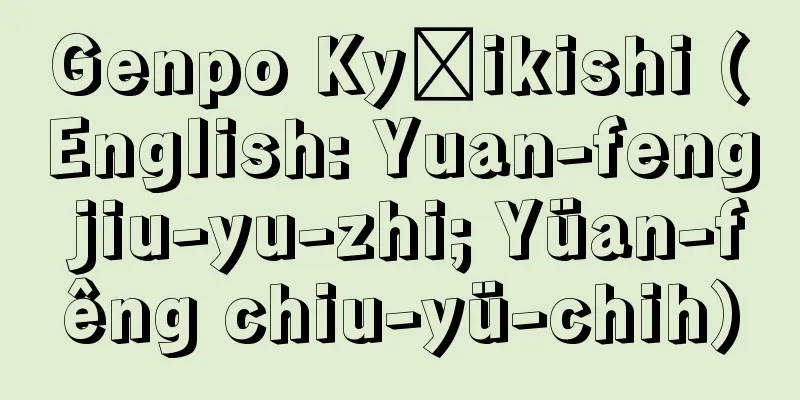Zendo - Zendo

|
A high priest of the Pure Land sect in the early Tang Dynasty in China. He is said to have been born in Linzi, Shandong Province, or Sizhou, Anhui Province. His surname was Zhu. As a boy, he became a monk under the monk Meisheng of Mizhou. When he was about 20 years old, he entered the monk Doshaku's school at Shibi Xuanzhong Temple in Shanxi Province, and became a believer in the chanting of the Nembutsu. He later retired to Goshin Temple on Mount Zhongnan in the outskirts of Chang'an, and occasionally promoted the Nembutsu faith at the Jodo-in Temple of Komyo-ji Temple in Chang'an. His writings are commonly referred to as "five parts and nine volumes," and the "Commentary on the Sutra of Contemplation of the Buddha of Immeasurable Life" (Kanmurai Sutra Commentary) goes beyond the traditional conceptual nembutsu and clarifies the seriousness of the Jodo sect, which is centered on the oral chanting of the name of Amida Buddha with one mind. He also re-edited the praising rites performed as Buddhist ceremonies in the Six Dynasties and Sui dynasties, completing the "Ges of Praise for Rebirth in the Pure Land," and further developing the "Hojisan" and "Banjusan" hymns. Honen (Genku) of Japan founded the Jodo sect based on this "Commentary on the Sutra of Contemplation," and established the foundation for the new popular Buddhism of the Kamakura period. During his lifetime, he copied 100,000 volumes of the Amitabha Sutra and painted 300 Pure Land Mandalas, and remnants of the Amitabha Sutra were discovered by the Otani Expedition in Tuyugou around 1910. In his later years, he also served as an inspector for the construction of the Great Vairocana Buddha at the Longmen Fengxian Temple in Luoyang under Empress Wu Zetian. His grave is located at the Shinkahara Koshaku Temple, and a temple was built there in 1980 to mark the 1,300th anniversary of his death. [Makita Akira February 16, 2017] [Reference items] | | | |Source: Shogakukan Encyclopedia Nipponica About Encyclopedia Nipponica Information | Legend |
|
中国、唐初の浄土宗の高僧。山東省臨淄(りんし)または安徽(あんき)省泗州(ししゅう)の生まれという。姓は朱氏。少年のころ密州の明勝(めいしょう)法師に就いて出家。二十余歳のころ山西省石壁玄中寺にて道綽(どうしゃく)の門に入り、唱名(しょうみょう)念仏の信奉者となった。その後長安郊外の終南山悟真(ごしん)寺に隠棲(いんせい)し、ときにふれて長安光明寺の浄土院で念仏信仰を鼓吹した。その著述は「五部九巻」と俗称されるが、『観無量寿経疏(かんむりょうじゅきょうしょ)』(観経疏)は、従来の観念の念仏から進んで、一心にもっぱら弥陀(みだ)の名号(みょうごう)を唱える口称(くしょう)の念仏を中心とする浄土宗の真面目(しんめんもく)を明らかにしたものである。また、六朝(りくちょう)・隋(ずい)代に行われていた仏教儀礼としての礼讃(らいさん)類を再編集して、『往生礼讃偈(おうじょうらいさんげ)』を完成し、さらに『法事讃(ほうじさん)』『般舟讃(ばんじゅさん)』などを整備した。日本の法然(ほうねん)(源空)はこの『観経疏』に基づいて浄土宗を開創し、鎌倉時代における新民衆仏教の基礎を固めたのである。生涯に阿弥陀経を10万巻書写し、浄土曼荼羅(まんだら)三百鋪(ぽ)を描き、その阿弥陀経の残欠が1910年ころ吐峪溝で大谷探検隊によって発見された。また晩年、則天武后の洛陽(らくよう)竜門奉先寺の大毘盧遮那仏(だいびるしゃなぶつ)造立に検校(けんぎょう)としてその職を果たした。その墓所遺跡は神禾原香積(こうしゃく)寺にあり、1980年、1300年の遠忌(おんき)に際してそこに堂宇が建立された。 [牧田諦亮 2017年2月16日] [参照項目] | | | |出典 小学館 日本大百科全書(ニッポニカ)日本大百科全書(ニッポニカ)について 情報 | 凡例 |
Recommend
Natsufuji (summer wisteria) - Millettia japonica
A creeping deciduous shrub of the legume family. A...
Dual - Sotsui (English spelling) dual
In mathematical theory, when two or more concepts ...
Original species - Genshu
It is a term that refers to the species or type t...
Italian style picture frame stage - Itaruashikigakubutchibutai
… What is noteworthy about the emergence of these...
Westphalia - Westphalia (English spelling)
The English name of a region in northwestern Nort...
Dried sardine (fried sea cucumber) - Dried sardine
A dried sea cucumber. Also called kinko (light cuc...
Porphyrio
…Length is about 10-40cm. Some birds, such as the...
Callionymus lunatus (English spelling)
...A general term for marine fish of the family C...
Stearyl alcohol
Chemical formula: CH 3 (CH 2 ) 17 OH. A higher ali...
Himemarukatsuobushimushi
[ Anthrenus verbasci ]. A food pest of the order C...
Anterior horn cell
…Poliovirus is a neurotropic virus that attacks t...
Geng Yin Yearbook - Kouin Nenjaku
In 690 (the year of the Koin Tiger), by order of E...
Hiyama
Folk performing art. This is a type of Bangaku (mo...
Ateles
…the name of a relatively large New World monkey ...
Desire under the Elms
A play by American playwright EG O'Neill. It p...









